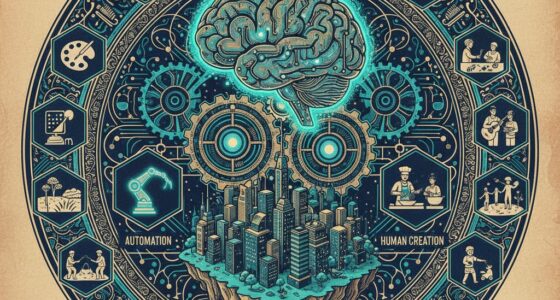Schools are increasingly integrating AI into their curricula and operations to prepare students for an automation-driven world. They focus on developing digital literacy, critical thinking, and ethical awareness while using AI tools for personalized learning and automation. Teachers are also adapting through ongoing training to keep pace with technological changes. If you want to understand how these changes are shaping education and what’s next, keep exploring the evolving role of AI in classrooms.
Key Takeaways
- Schools are integrating AI tools for personalized learning, automation, and digital literacy to prepare students for an AI-driven future.
- Curricula now include AI fundamentals, emphasizing critical thinking, ethics, and data privacy skills.
- Teachers receive professional development to effectively incorporate AI and adapt to technological changes.
- Challenges like data privacy, bias, and accessibility are addressed through policies and ethical guidelines.
- Overall, educational systems are evolving to equip students with skills necessary for collaboration and success in an AI-powered world.
The Growing Role of AI in Educational Environments

AI is increasingly transforming educational environments by providing personalized learning experiences and automating routine tasks. You’ll notice how AI tailors resources to match each student’s strengths and needs, making learning more effective and engaging. Automated grading and assessments save teachers hours, giving them more time to focus on individual student support. AI-powered tools boost student participation, especially in subjects like math, where they’re highly valued. Schools are adopting AI to streamline operations, improve student outcomes, and prepare students for a tech-driven world. However, integrating AI isn’t without challenges. Infrastructure costs, ethical concerns, and the need for teacher training remain barriers. Despite these hurdles, the growing presence of AI indicates a significant shift toward more adaptive, efficient, and data-driven education systems. Additionally, the use of educational technology like AI-driven projectors and interactive tools is becoming more common, further enhancing the learning environment.
How Schools Are Integrating Automation Into the Curriculum

As schools recognize the transformative potential of automation, they are actively embedding these technologies into their curricula to enhance learning and operational efficiency. You’ll notice many institutions adopting AI tools for personalized learning, allowing students to work at their own pace and focus on areas needing improvement. Automated grading systems streamline assessments, giving instant feedback and reducing teacher workload. Schools are also integrating AI-powered chatbots to support student inquiries outside class hours. In addition, some curricula now include lessons on AI fundamentals, teaching students how automation works and its implications. These efforts aim to prepare students for an AI-driven future by familiarizing them with automation tools and fostering digital literacy. Additionally, integrating Predictive Analytics for Small Business concepts can help students understand how data-driven insights influence decision-making in real-world scenarios. Overall, schools are making automation a core component of education to better equip students for tomorrow’s world.
Skills Students Need to Thrive in an AI-Driven World

To thrive in an AI-driven world, you need strong digital literacy skills that let you navigate and evaluate technology effectively. Critical thinking is essential to question AI outputs and make informed decisions. Additionally, understanding ethical AI use helps you use these tools responsibly and avoid potential pitfalls. Developing awareness of data privacy challenges is also crucial to protect your personal information in an increasingly digital environment.
Digital Literacy Skills
In an increasingly automated world, students must develop strong digital literacy skills to navigate and succeed. You need to understand how digital tools work, evaluate information critically, and recognize AI-generated content. Being digitally literate means more than just using technology; it involves appraising sources, understanding privacy issues, and knowing how to protect your data. Schools should teach you how to differentiate credible information from misinformation and how to responsibly interact with AI systems. Developing these skills helps you adapt quickly to new technologies and avoid pitfalls like bias or manipulation. As AI continues to evolve, mastering digital literacy becomes essential for making informed decisions, collaborating effectively, and staying competitive in future workplaces. Furthermore, understanding the risks associated with emerging merchant services and payment technologies can help students recognize potential security vulnerabilities and regulatory challenges they may encounter in digital transactions.
Critical Thinking Abilities
Mastering an AI-driven world requires sharp critical thinking skills because technology can both inform and mislead. You need to evaluate information carefully, questioning sources and identifying biases. AI tools can provide vast amounts of data, but they can also spread misinformation if you’re not vigilant. To thrive, you must analyze problems, consider multiple perspectives, and make informed decisions based on evidence. Schools should prioritize teaching students how to differentiate between accurate and false information and develop reasoning skills. Critical thinking enables you to adapt to rapid technological changes, spot ethical issues, and solve complex problems creatively. As AI continues to evolve, your ability to think critically becomes essential for charting a course through challenges and making responsible choices in an increasingly automated world. Developing these skills also involves understanding the fundamentals of bedroom design, which emphasizes clarity, organization, and a calm environment, much like the mental clarity needed to navigate an AI-rich landscape.
Ethical AI Use
As AI becomes more integrated into education, understanding ethical AI use is essential for students to navigate this new landscape responsibly. You need to recognize issues like data privacy, bias, and misuse. Learning ethical AI practices helps you avoid plagiarism and understand the limitations of algorithms. It’s important to question how AI decisions are made and hold creators accountable. Schools should teach you to use AI tools responsibly, emphasizing transparency and fairness. Incorporating principles of home improvement can also inspire responsible management of digital resources and information.
Challenges and Ethical Concerns in AI Adoption for Education

As you consider integrating AI into education, you need to think about data privacy risks that could expose student information. Bias and fairness also pose challenges, since algorithms might reinforce existing inequalities if not carefully monitored. Addressing these ethical concerns is essential to make certain AI benefits all students without compromising trust or equity. Additionally, the development of robust safety measures is crucial to prevent vulnerabilities and ensure reliable AI deployment in educational settings.
Data Privacy Risks
Have you ever considered how the increasing use of AI in education raises serious data privacy concerns? As schools collect more student information to personalize learning, the risk of data breaches and misuse grows. You need to be aware of how sensitive data might be vulnerable to hacking or unauthorized access.
- Personal details, grades, and behavioral data can be targeted by cybercriminals.
- Data collection without clear consent raises ethical questions about student rights.
- Schools may share data with third-party vendors without transparency.
- Inadequate security measures can lead to leaks, compromising student privacy.
Protecting student data requires strict policies, transparent data practices, and robust cybersecurity. You must stay informed and advocate for responsible AI use in education.
Bias and Fairness
Bias and fairness are critical issues when integrating AI into education, as these systems can inadvertently reinforce existing inequalities. If AI algorithms are trained on biased data, they may favor certain student groups over others, leading to unfair outcomes. This can affect assessments, personalized learning, and resource allocation, widening the achievement gap. You need to be aware that without proper oversight, AI tools might perpetuate stereotypes or overlook diverse learning needs. Ensuring fairness requires transparent algorithms, diverse training datasets, and ongoing monitoring. Educators and developers must collaborate to address biases proactively. By prioritizing ethical AI design, you can help create a more equitable educational environment where all students have equal opportunities to succeed. Additionally, understanding the cost factors involved in AI implementation can help schools allocate resources effectively and avoid unforeseen expenses.
Opportunities for Personalization and Accessibility Through AI

AI offers remarkable opportunities to tailor education to individual students’ needs and abilities. You can benefit from personalized learning experiences that adapt in real-time, helping you stay engaged and address your unique strengths. AI tools can identify gaps in your understanding and provide targeted support, ensuring you don’t fall behind. Additionally, AI enhances accessibility by offering features like text-to-speech, language translation, and accommodations for students with disabilities. This creates a more inclusive environment where everyone can participate fully. Moreover, incorporating thorough due diligence into the development of AI educational tools can ensure they meet high standards of accuracy and reliability.
Preparing Educators for a Tech-Enhanced Classroom Future

To effectively navigate the shift toward a tech-enhanced classroom, educators must develop new skills and adapt their teaching methods. You need to embrace digital literacy, understanding how AI tools function and their potential benefits and pitfalls. This involves ongoing professional development focused on integrating AI into lesson plans, assessments, and student engagement strategies. You should also learn ethical considerations, such as protecting student data and addressing bias. Flexibility is key—you must stay open to experimenting with new technologies and adjusting your approaches based on effectiveness. Collaboration with colleagues, technologists, and administrators will help you stay informed about emerging tools and best practices. Staying updated on educational technology trends can provide valuable insights into integrating AI effectively. Ultimately, prepared educators can confidently guide students through an AI-powered learning environment, fostering critical thinking and responsible use of technology.
Strategic Recommendations for Future-Ready Education Systems

Preparing educators to navigate a rapidly evolving, technology-driven classroom is only the first step. To build future-ready education systems, you need strategic actions that foster adaptability and innovation. Focus on integrating AI literacy into curricula, ensuring students develop critical thinking alongside technical skills. Invest in ongoing teacher training to keep up with emerging tools and ethical considerations. Foster collaboration among educators, technologists, and policymakers to create cohesive, scalable solutions. Additionally, prioritize infrastructure upgrades and ethical frameworks to address privacy, bias, and accessibility concerns. These steps will help prepare students for an AI-driven workforce, ensuring they’re adaptable, critical thinkers, and responsible users of technology.
- Incorporate AI and digital literacy into standard curricula
- Provide continuous, hands-on teacher training
- Develop ethical guidelines and privacy policies
- Promote cross-sector collaboration and innovation
Frequently Asked Questions
How Can Schools Balance AI Integration With Traditional Teaching Methods?
You can balance AI integration with traditional teaching by blending personalized digital tools with face-to-face interactions. Use AI to enhance lessons, automate grading, and support individual student needs, while maintaining classroom discussions, hands-on activities, and critical thinking exercises. This approach guarantees students develop technical skills alongside social and emotional abilities, creating a well-rounded education. Regularly evaluate your methods to adapt to new AI advancements and address ethical concerns.
What Policies Ensure Ethical Use of AI in Student Assessment?
You should establish clear policies that define acceptable AI use in assessments, emphasizing transparency and fairness. Implement guidelines that prevent cheating and plagiarism while promoting responsible AI usage. Regularly train teachers and students on ethical standards, privacy, and bias concerns. Enforce strict data protection measures and develop oversight committees to monitor AI tools’ compliance. These policies guarantee assessments remain fair, unbiased, and uphold academic integrity in an AI-driven educational environment.
How Are Students Being Taught Responsible AI Usage and Digital Literacy?
You’re being taught responsible AI usage and digital literacy through integrated lessons that focus on ethical considerations, privacy, and proper AI application. Schools encourage critical thinking about AI’s role and potential biases, helping you understand its benefits and risks. You’re also guided on avoiding plagiarism and misuse, emphasizing the importance of transparency and accountability. These skills prepare you to navigate AI-driven environments confidently, ensuring responsible and ethical use in your academic and future professional life.
What Support Systems Exist for Teachers Adapting to Ai-Driven Classrooms?
You’re supported through training programs that focus on integrating AI tools into your teaching. Schools are increasingly offering workshops, online courses, and professional development to boost your confidence with AI-driven platforms. Additionally, collaboration with colleagues helps share best practices. Many institutions also provide technical support and resources to troubleshoot issues quickly, ensuring you stay updated on the latest AI features. This support system aims to make your shift smoother and enhance your teaching effectiveness.
How Will AI Impact Future Educational Equity and Access Worldwide?
AI can substantially improve educational equity and access worldwide by providing personalized learning, especially in underserved areas. You’ll see AI-driven tools breaking down language barriers, offering tailored support, and enabling remote learning for students who lack traditional resources. As you integrate these technologies, you’ll help bridge gaps, ensuring more students worldwide get quality education regardless of their location or socioeconomic status. However, addressing infrastructure and ethical concerns remains essential for lasting impact.
Conclusion
As AI continues to reshape education, it’s clear that embracing automation isn’t just a choice—it’s a necessity. When you adapt your skills and mindset, you’ll find yourself better prepared for an AI-driven world. Coincidentally, the more you integrate technology and stay ahead of the curve, the more opportunities open up for personalized learning and growth. Ultimately, your proactive approach today sets the foundation for success tomorrow in this rapidly evolving landscape.









